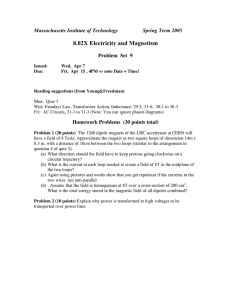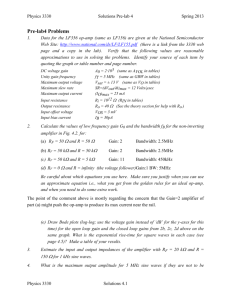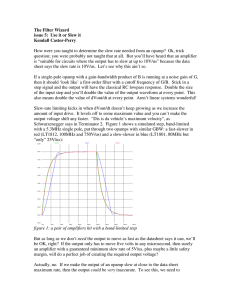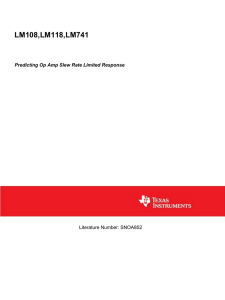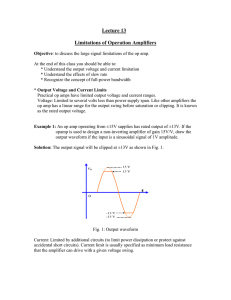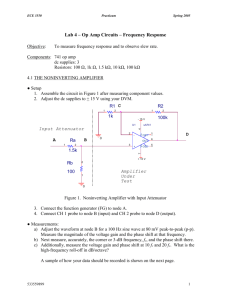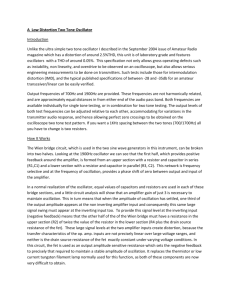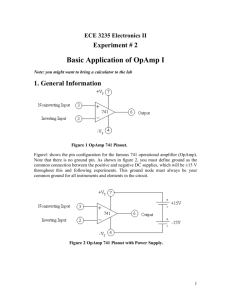Lab 6 Manual
advertisement
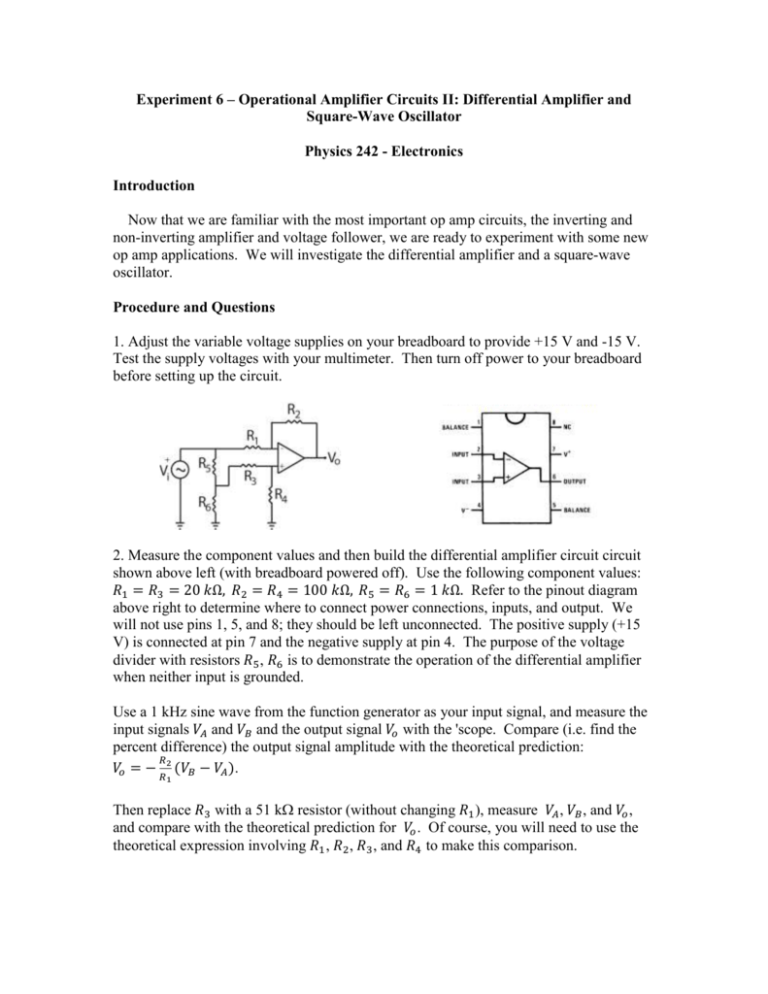
Experiment 6 – Operational Amplifier Circuits II: Differential Amplifier and Square-Wave Oscillator Physics 242 - Electronics Introduction Now that we are familiar with the most important op amp circuits, the inverting and non-inverting amplifier and voltage follower, we are ready to experiment with some new op amp applications. We will investigate the differential amplifier and a square-wave oscillator. Procedure and Questions 1. Adjust the variable voltage supplies on your breadboard to provide +15 V and -15 V. Test the supply voltages with your multimeter. Then turn off power to your breadboard before setting up the circuit. 2. Measure the component values and then build the differential amplifier circuit circuit shown above left (with breadboard powered off). Use the following component values: 𝑅1 = 𝑅3 = 20 𝑘Ω, 𝑅2 = 𝑅4 = 100 𝑘Ω, 𝑅5 = 𝑅6 = 1 𝑘Ω. Refer to the pinout diagram above right to determine where to connect power connections, inputs, and output. We will not use pins 1, 5, and 8; they should be left unconnected. The positive supply (+15 V) is connected at pin 7 and the negative supply at pin 4. The purpose of the voltage divider with resistors 𝑅5 , 𝑅6 is to demonstrate the operation of the differential amplifier when neither input is grounded. Use a 1 kHz sine wave from the function generator as your input signal, and measure the input signals 𝑉𝐴 and 𝑉𝐵 and the output signal 𝑉𝑜 with the 'scope. Compare (i.e. find the percent difference) the output signal amplitude with the theoretical prediction: 𝑅 𝑉𝑜 = − 𝑅2 (𝑉𝐵 − 𝑉𝐴 ). 1 Then replace 𝑅3 with a 51 k resistor (without changing 𝑅1 ), measure 𝑉𝐴 , 𝑉𝐵 , and 𝑉𝑜 , and compare with the theoretical prediction for 𝑉𝑜 . Of course, you will need to use the theoretical expression involving 𝑅1 , 𝑅2 , 𝑅3 , and 𝑅4 to make this comparison. 3. Measure your component values and build the square-wave oscillator circuit shown above. Use the following component values: C = 10 nF, R = 20 k, 𝑅1 = 10 k, and 𝑅2 = 20 k. Observe the output signal (pin 6) with the 'scope: you should see a square wave. Measure the peak-to-peak amplitude and the frequency of the square wave. Compare the 1+𝜆 𝑅1 frequency to the theoretically predicted expression: 𝑓 −1 = 2𝑅𝐶 ln 1−𝜆, where 𝜆 = 𝑅 +𝑅 . 1 2 Connect the 'scope to the inverting input (pin 2) and observe the waveform. Draw a sketch of the waveform, and indicate the measured peak-to-peak amplitude and period on your sketch. The compare the amplitude you observed with the theoretically predicted amplitude. The theory predicts that the capacitor charges until it reaches voltage ±𝜆𝑉𝑜 , where 𝑉𝑜 is the output voltage (which is equal to its positive or negative maximum, close to the supply voltages). Last, with the 'scope connected to measure 𝑉𝑜 (at pin 6), expand the time-scale so that you can measure the slew rate of the op amp. The slew rate is the maximum rate of change of the output voltage, usually given in units of volts per microsecond. To make the measurement, you'll need to measure the time needed for the square-wave voltage to make its negative to positive transition. Set the time/div around 1 s, and try setting the coupling to "norm" and adjusting the "trigger level" control to display the voltage during this rapid transition. Report your measured slew rate in units of V/s. Then check the data sheet for the LF356N op amp, available at www.jameco.com, state the minimum and typical slew rate values stated on the data sheet, and state whether the slew rate you measured is consistent with the specifications for this component.
